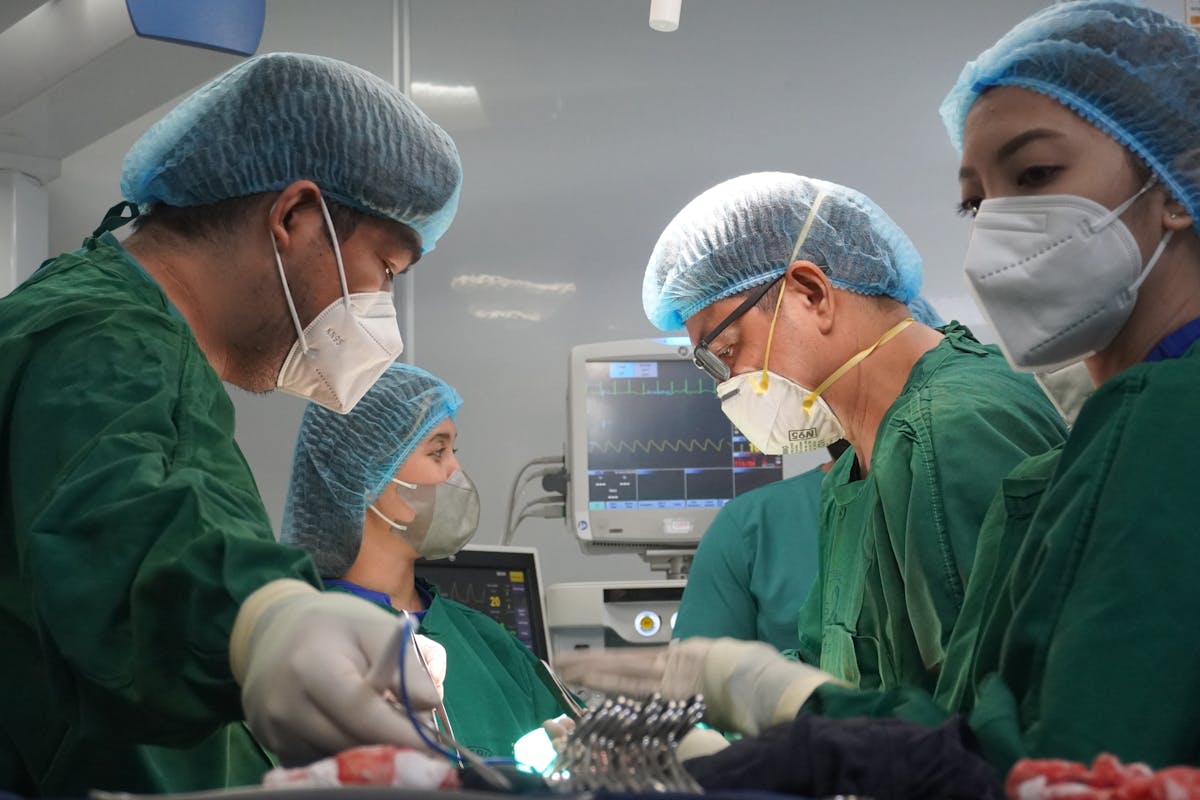The length of neck surgery, a topic of significant interest to both patients and medical professionals, is influenced by an array of factors including the specific procedure being performed, the surgeon’s expertise, and individual patient circumstances. Procedures such as cervical disc replacement and spinal fusion surgeries, for instance, have markedly different average durations. What then, one might ask, are the typical time frames for these procedures, and how does the complexity of each surgery impact this? Understanding these nuances is important in setting appropriate expectations and aiding the preparation process for such a significant medical procedure.
Understanding Neck Surgery
To fully understand the intricacies of neck surgery, it is essential to explore its underlying principles, procedures, and the typical surgical techniques employed by medical professionals. Neck surgery, often a solution for spinal disorders or severe neck pain, is a complex field that requires substantial expertise and precision.
However, before resorting to surgery, medical practitioners typically exhaust all possible neck surgery alternatives, including physiotherapy, medication, and lifestyle changes. These non-invasive treatment options are preferred due to the risks involved with neck surgery. While surgical intervention can provide long-term relief, it is not without its perils.
Among the risks involved in neck surgery are nerve injury, infection, excessive bleeding, and adverse reactions to anesthesia. Additionally, there’s the risk of non-improvement or even a worsening of the symptoms post-surgery. Given these potential complications, it is essential to note that neck surgery is generally considered a last resort, and patients are often subject to a rigorous pre-surgery evaluation process.
This detailed understanding of neck surgery, inclusive of the alternatives and risks, provides a foundation for further discussions about the specifics of the surgical procedure, which will be the focus of the next subtopic.
Basic Neck Surgery Procedure
In considering the duration of neck surgery, a thorough understanding of the basic neck surgery procedure is essential. This involves a systematic examination of the procedural steps, from the initial incision to the final suturing, as well as the necessary post-operative care. By dissecting these elements, we can gain an accurate perspective on the timeline and intricacy of neck surgery.
Procedure Steps Overview
The basic neck surgery procedure typically involves several distinct stages, starting with pre-operative preparations, then moving on to the surgical process itself, and finally focusing on post-operative care and recovery. Prior to surgery, patients may undergo evaluations to determine suitable anesthesia types, considering factors such as overall health, the complexity of the procedure, and patient preference. General anesthesia is commonly used for neck surgeries, rendering the patient unconscious during the operation. Following the surgical procedure, the patient’s nutritional intake, or recovery diet, becomes essential. A soft or liquid diet is often recommended initially to ease swallowing. This diet may include foods like broth, yogurt, or mashed potatoes, gradually introducing denser foods as healing progresses. This overview provides a general framework for understanding the stages of neck surgery.
Post-Operative Care Instructions
Following the surgical procedure, a meticulous approach to post-operative care becomes a pivotal factor in patient recovery after a basic neck surgery procedure. The primary focus areas generally include pain management and rehabilitation exercises. Pain management is vital to guarantee a comfortable healing process. This may involve prescribed medication, as well as non-pharmacological techniques such as relaxation exercises. Tailored rehabilitation exercises are equally essential to restore mobility and strength in the neck. The exercises often start gently and progressively increase in intensity under the guidance of a physiotherapist. The specifics of post-operative care are usually personalized, based on the patient’s overall health, the complexity of the surgery, and the surgeon’s professional assessment. Proper adherence to these instructions can greatly enhance the recovery trajectory.
Factors Influencing Surgery Duration
The duration of neck surgery can be greatly influenced by several factors, two of which are the type of neck surgery being performed and the experience level of the surgeon. Different kinds of neck surgeries entail varying complexities, thereby affecting the time required for their completion. Similarly, a surgeon’s proficiency and expertise, gained through years of practice, can contribute to the efficiency and speed of the operation.
Type of Neck Surgery
Variations in the duration of neck surgeries largely depend on the complexity and type of the procedure performed, including factors such as whether it’s a cervical discectomy, cervical fusion, or a cervical disc replacement. The cervical discectomy, for instance, may take less time compared to a cervical fusion due to its less invasive nature. However, it also carries its own set of surgery risks such as nerve damage or infection. On the other hand, a cervical fusion might be more complex and lengthy, but it offers more permanent solutions to recurring neck problems. Insurance coverage might differ depending on the type of surgery, taking into account the procedure’s complexity, inherent risks, and the expected recovery time.
Surgeon’s Experience Level
In addition to the type of operation, the surgeon’s level of experience significantly influences the duration of neck surgery, with seasoned surgeons often performing procedures more swiftly and efficiently than their less experienced counterparts. The surgeon’s training, as an essential factor, can drastically impact the surgery’s duration. A highly trained surgeon, armed with extensive knowledge and surgical expertise, can navigate through complex procedures with precision, reducing both the operation time and potential complications. However, less experienced surgeons may require more time to complete the same operation, highlighting the steep learning curve inherent in surgical practice. Therefore, a surgeon’s experience level plays a pivotal role in determining the duration of neck surgery, underscoring the importance of choosing a seasoned professional for such delicate procedures.
Common Types of Neck Surgeries
Exploring the domain of neck surgeries, it becomes apparent that there are several types, each distinguished by the precise anatomical area addressed and the specific issue being rectified. Anterior cervical discectomy and fusion (ACDF) is a common procedure to treat nerve root or spinal cord compression by removing part or all of an intervertebral disc. Cervical artificial disc replacement (ADR) is another option where a problematic disc is replaced by an artificial one. Cervical laminectomy involves removing the bone at the rear of your vertebrae to create more space for your spinal nerves or spinal cord.
While these surgeries offer potential relief from chronic neck pain, they also come with their share of neck surgery risks. These can include infection, nerve damage, difficulty swallowing or speaking, and persistent pain. Discussing these risks with your surgeon before deciding on a procedure is important.
Insurance coverage for neck surgeries varies widely, depending on the procedure, your insurance provider, and your specific policy details. It’s important to consult with your insurance company before scheduling a surgery, to avoid unexpected out-of-pocket expenses. Understanding the common types of neck surgeries and their associated risks and insurance implications is an important part of the decision-making process.

Duration of Cervical Disc Replacement
The duration of cervical disc replacement, a type of neck surgery, is influenced by two key factors: the length of the surgery process itself and the time required for post-operation recovery. The surgical procedure’s duration can vary considerably depending on the patient’s condition and the complexity of the operation. Meanwhile, the recovery period is contingent upon several elements, including the patient’s overall health, the success of the surgery, and the efficacy of post-operative care.
Surgery Process Duration
To guarantee, it is crucial to mention that a cervical disc replacement surgery can last from one to two hours, depending on the complexity of the procedure and the patient’s overall health. This duration includes the time needed for anesthesia administration, which varies based on individual patient factors. The surgery risks are heightened if the procedure extends beyond the anticipated time due to unforeseen complications, as prolonged anesthesia duration can lead to potential side effects like respiratory or cardiovascular issues. Hence, surgeons take meticulous measures to make certain the operation process is executed efficiently and within the projected timeline. It is important to note that the actual time spent on the operating table represents only a fragment of the overall surgical journey. The pre-operative preparations and post-operative recovery are also significant components of the complete procedure time.
Post-Operation Recovery Time
Upon completion of a cervical disc replacement surgery, the patient’s recovery phase commences, which can span several weeks to months, hinging on the individual’s health status and the success of the operation. Pain management becomes a vital aspect during this period and typically involves a combination of medications, physical therapy, and sometimes, psychological support. Rehabilitation exercises are introduced gradually, designed to restore strength and mobility in the neck region. The patient’s commitment to these exercises can greatly influence the duration and success of the recovery phase. However, it’s essential to recognize that each recovery timeline is specific to the individual, and can be influenced by various factors including age, overall health, and the complexity of the surgery.
Time Frame for Spinal Fusion Surgery
In considering spinal fusion surgery, one must understand that it is an intricate procedure that can take several hours to complete, depending on the number of vertebrae being fused and the specifics of the patient’s condition. The surgery’s duration may range from 3 to 6 hours or more, necessitating significant preoperative planning and postoperative care.
When contemplating spinal fusion, it’s also important to weigh the potential Fusion Surgery Risks, which can include infection, bleeding, nerve damage, or complications related to anesthesia. It is equally essential to contemplate Spinal Fusion Alternatives such as physical therapy, pain management, or minimally invasive procedures. Each alternative holds its own set of benefits and risks, which can influence the surgical decision and potential recovery time.
Accurate prediction of the surgery duration is crucial in ensuring proper resource allocation, patient expectations management, and risk mitigation. A detailed understanding of the procedure, including the potential risks and alternatives, can provide patients with a thorough view of what to expect, thereby aiding in informed decision-making. It is, however, important to discuss these aspects extensively with the healthcare provider before making a final decision.
Anterior Cervical Discectomy and Fusion Timing
Shifting our focus to the timing of Anterior Cervical Discectomy and Fusion (ACDF), it’s important to understand that this surgical procedure, designed to alleviate spinal cord or nerve root pressure in the neck, usually takes between 1 to 2 hours to perform, although the duration can vary based on the complexity of the condition and the patient’s overall health status.
But the time spent in the operating theatre is just the beginning. Beyond this, recovery complications can extend the timeline considerably. ACDF procedures, like most surgeries, carry risks, including infection, adverse reactions to anesthesia, and, in rare cases, damage to the spinal cord or nerves. These can lead to additional health problems, extended hospital stays, and a delay in the patient’s return to normal activities.
The importance of physical therapy in the recovery process cannot be overstated. Early and consistent engagement in physical therapy can help to reduce the risk of complications and expedite the healing process. It aids in reducing pain, improving flexibility, and restoring function, thus reducing the total recovery time. Therefore, when considering the ACDF timing, one must consider both surgery and recovery phases for an accurate estimation.
Posterior Cervical Laminectomy Duration
Shifting our focus to Posterior Cervical Laminectomy, it is important to highlight that the duration of this surgical procedure, aimed at alleviating pressure on the spinal cord or nerves in the neck by removing part or all of the vertebral bone (lamina), typically ranges between 2 to 3 hours. However, this timeframe can vary depending on the complexity of the patient’s condition and overall health status.
Laminectomy complications, such as infection, nerve damage, or spinal fluid leak, can potentially extend the duration of the surgery. A thorough preoperative assessment allows surgeons to anticipate these complications and develop a surgical strategy accordingly, which can minimize the time spent in the operating room.
In addition, the patient’s lifestyle factors, such as smoking or obesity, can potentially complicate the procedure and extend its duration. These factors can impede the patient’s healing process, increase the risk of complications, and consequently, prolong the surgical and recovery period. Hence, a detailed understanding of the patient’s lifestyle and medical history is essential in estimating the precise duration of a Posterior Cervical Laminectomy.
Preparing for Your Neck Surgery
An extensive preparation for neck surgery, covering both physical and mental aspects, is essential to facilitate a smoother surgical process and promote ideal recovery outcomes. The preparation phase involves addressing pre surgery anxiety, following a nutrition plan, and other health-related aspects.
A detailed, analytical, and accurate approach towards preparation can be broken down into these four components:
- Pre-Surgery Consultation: It is important to understand the procedure fully. This includes the surgical process, risks involved, and expected outcomes. This knowledge can help alleviate pre surgery anxiety.
- Nutrition Planning: Proper nutrition is essential for ideal recovery. A tailored diet plan, usually high in protein and low in sodium, should be followed in the weeks leading up to the surgery.
- Physical Preparation: Regular exercise, as advised by the surgeon or physical therapist, is crucial to enhance overall health and boost recovery post-surgery.
- Mental Health Management: Addressing and managing pre surgery anxiety is important. Techniques such as meditation, counseling, or even medication can assist in reducing anxiety and promoting a positive mindset for the surgery.
Post-Surgery Recovery Time
The duration of recovery following neck surgery varies greatly depending on the nature of the procedure, the individual’s overall health, and the quality of post-operative care received. It can range from a few weeks to several months.
The importance of physical therapy in this recovery process cannot be overstated. Physical therapy plays a vital role in restoring strength and flexibility to the neck muscles, improving mobility and reducing pain. It is often initiated within a few days after surgery, under the guidance of a professional physical therapist.
Rehabilitation exercises are another essential aspect of post-operative care. These exercises, which are typically prescribed by the physical therapist, help to improve the range of motion and prevent scar tissue formation. They may involve gentle neck stretches, strengthening exercises, and aerobic activity such as walking.
It’s important to note that the recovery timeline is not linear; patients may experience ups and downs along the way. Some days may bring significant improvement, while others may involve setbacks. However, with consistent physical therapy and commitment to rehabilitation exercises, most patients can expect to see gradual, steady progress over time.
Potential Complications and Delays
Despite meticulous planning and execution, neck surgery could entail potential complications and delays, greatly impacting the recovery timeline and patient experience. A deep understanding of complication risks and delay causes can be valuable in preparing for this surgical procedure.
- Infection: Postoperative infections are one of the most common complications associated with neck surgery. These can occur at the surgical site or internally, leading to increased recovery time.
- Bleeding: Excessive bleeding during or after the procedure can lead to significant delays in the recovery process. It might also necessitate additional procedures to manage the bleeding.
- Anesthetic complications: Anesthesia, though generally safe, can sometimes cause complications such as allergic reactions, breathing problems, or heart complications. These can lead to delays in the patient’s discharge or longer hospital stays.
- Nerve damage: As the neck houses critical nerve pathways, there’s a risk of nerve damage during surgery. This could result in pain, numbness, or even paralysis in extreme cases, leading to an extended recovery period.
Managing Expectations: Realistic Timelines
Having considered the potential complications and delays of neck surgery, it is equally important for patients and caregivers to align their expectations with the realistic timelines of recovery following the procedure. The duration of recovery varies widely, depending on factors such as the specific type of surgery, the patient’s overall health, and the efficiency of pain management and rehabilitation protocols.
Pain management is a pivotal aspect of post-operative care. Effective pain management can expedite recovery by enabling patients to participate more fully in rehabilitative exercises, thereby potentially shortening the recovery timeline. In contrast, inadequate pain management can hinder rehabilitation and prolong recovery.
Rehabilitation protocols, another critical component of recovery, are typically tailored to the patient’s specific needs and progress. These protocols involve a range of therapies designed to restore function and mobility, and their intensity and duration have a significant impact on the recovery timeline.
It is essential for patients to understand that recovery is an individual process and that the timeline can fluctuate based on various factors. By engaging openly with their healthcare providers about their recovery expectations, patients can contribute to an ideal recovery plan that balances their needs with a realistic timeline.
Frequently Asked Questions
What Is the Cost of Different Types of Neck Surgeries?
The cost of neck surgeries can vary widely depending on the specific procedure, insurance coverage, and regional price variations. It’s critical to consult with healthcare providers and insurers for accurate cost estimates and coverage details.
How Does Neck Surgery Impact Daily Life Activities During Recovery?
Post surgery mobility can be greatly affected following neck surgery, impacting daily life activities like meal preparation. Challenges may include limited movement, pain, and potential requirement for assistance in tasks until recovery is complete.
Are There Any Non-Surgical Alternatives to Neck Surgery?
Yes, there are non-surgical alternatives to neck surgery. Chiropractic benefits include pain reduction and increased mobility. Acupuncture also has proven efficacy in relieving neck pain by stimulating specific points on the body.
What Is the Success Rate of Common Types of Neck Surgeries?
The success rate of common neck surgeries is generally high, though it can vary based on factors like surgery complications and the patient’s post-surgery rehabilitation. Detailed, accurate analysis is needed for individual prognosis.
What Types of Anesthesia Are Typically Used in Neck Surgeries?
In neck surgeries, anesthesia selection typically involves general anesthesia, due to the complexity of the procedure. The selection process considers patient’s health status and potential anesthesia side effects, to guarantee patient safety and comfort.


